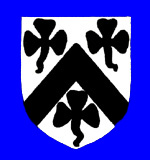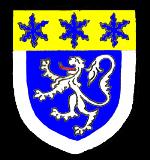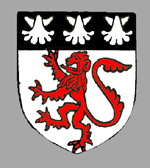The Manor of Lovells Bury

The Duncombe family coat of arms
Volume III of The Victoria County History was published in 1912 and gives the history of all the manors in Potsgrove. Lovells or Lovells Bury Manor was owned by the overlord of all the Potsgrove manors, Gilbert de Clare, Earl of Gloucester. The earls remained overlords until 1460 when the overlord became the Abbot of Saint Albans. The abbey was dissolved in 1539 and the last overlord mention in the historical record was Sir Edward Duncombe, who held Potsgrove and Blankfront manors, in 1638.
The manor is named after Philip Lovel who was tenant of the manor under the Earl of Gloucester in 1256. By 1362 the manor was in the hands of the Everard family who, in that year, sold it to John de Morton of Woburn.

The Rufford family coat of arms
In 1428 the manor was held by Thomas Rufford and in 1465 his widow Joan FitzGeoffrey died in possession of a mansion called Lovells Bury. The site of this manor house still exists as depressions in the field just east of Sheep Lane and just north of the road to the village of Potsgrove. These depressions can be seen clearly from the ridge above and even more clearly from the air, being the remains of the moats around former house. The site is surrounded by wonderfully preserved medieval ridge and furrow and furlong boundaries and appears to have been cut into the ridges and furrows and so post-dates them. The manor house, known as The Hoult, was still extant in 1663 as it appears on an estate map of that date as seen below [R1/62].
![The Hoult on a map of 1673 [R1/62]](/CommunityHistories/Potsgrove/PotsgroveImages/The Hoult on a map of 1673 [R1-62].jpg)
The Hoult on a map of 1663 [R1/62]
The Bedfordshire Historic Environment Record [HER] contains information on the county’s historic buildings and landscapes and summaries of each entry can now be found online as part of the Heritage Gateway website. The entry for the moat [HER 37] describes it as v-shaped in profile with the bank standing approximately 2.5 metres from the bottom of the ditch. The enclosed platform area is about 108 metres by 96 metres with an entrance causeway on the eastern side. A secondary moat stands in the south-east corner and is 34 metres square and stone and brick foundations are visible inside it (this being the structure shown on the map above representing the manor house itself). The uneven nature of the ground in both enclosures gives an idea where structures used to stand.

The site of The Hoult seen from the ridge February 2012
The moat and furlongs/ridge and furrow are all now a Scheduled Monument (one of the two largest Scheduled Monuments in the county in terms of area). Originally just the moat was scheduled but as this is now one of the largest continuous blocks of ridge and furrow, grouped into furlongs, to survive in the county the former Bedfordshire County Council was keen to see it preserved. Initially English Heritage just included the furlongs immediately adjacent to the moat but later it was persuaded to include the full extent which survives.
There is a low, circular mound near a stream running from the earthworks towards the road to the village [HER 9957]. It is possible that this represents a medieval rabbit warren attached to the manor house. Rabbits are not native, they were brought to England by the Romans as a source of food. By the Middle Ages they were kept in warrens, controlled by a warrener, to house them and allow them to be farmed for food.
The Rufford family continued as tenants of the manor into the 16th century. By 1588 the Lady of the Manor was Ellen Saunders, who married William Duncombe. The Duncombe family then held the manor until 1706 when it was sold to Allen, Lord Bathurst who in turn sold it to Sir Gregory Page, a director of the East India Company, in 1724. In 1799 the manor was held by Sir Philip Monoux in the right of his wife Elizabeth, daughter of Ambrose Riddell and he quitclaimed it to Thomas Lodington.

The Inglis family coat of arms
By 1854 the manor was in the hands of Sir Robert Inglis of Milton Bryan. In that year he sold the manor to the Duke of Bedford and the dukes held it into the 20th century. A succession of Law of Property Acts in the 1920s extinguished all manorial incidents, courts and copyhold tenure of land. This effectively abolished manors in all but name.

The coat of arms of the Dukes of Bedford